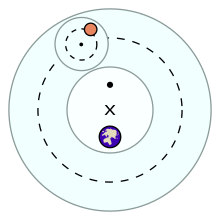Solar System/History of Scientific Theories
Throughout history there have been many different theories and changing ideas about the universe, building upon and contradicting each other. Great minds have measured the planets and calculated their distance and movements. One of the early societies that was famed for the accuracy and inventiveness of their theories was that of Ancient Greece.
As early as 230BC, Aristarchus of Samos suggested a heliocentric model of the universe and correctly ordered the planets in distance from the sun. His ideas were not accepted and mainstream and mathematicians such as Aristotle still supported a geocentric model. Aristotle’s contributions to astronomy covered theorems about the substance of the stars and their philosophy. For all of the ancient world and much of the modern, astronomy and astrology were intermingled and indistinguishable. Ptolemy was born over 200 years after Aristarchus’s and Aristotle’s death. Greek by birth, he lived and studied in Roman Egypt. He based his models on existing observations, using methods developed by the Babylonians. His geocentric proposal was widely accepted until Copernicus’s time. It proposed that the earth was stationary and the stars and each of the planets rotated around it in spheres.
Copernicus was born in Poland in 1473 almost 1400 years after Ptolemy. His most profound contribution was to challenge the geocentric model and propose a heliocentric one citing Aristarchus. He proposed that the sun was the centre of the universe and ordered the planets around it. Tycho Brahe did not adopt Copernicus’s model but designed an altered geocentric one, in which the sun orbited the earth and the other planets orbited the sun. This was the model accepted by the church when conventional geocentrism was implausible but Copernican heliocentrism considered sacrilegious. Johannes Kepler, a contemporary of both Copernicus and Brahe, Was the first to suggest that the planets moved in ellipses. He also discussed observations and theories with Galileo.
Galileo, born 1564, supported Copernicus’s theories. He is famous for his methods, which were very observation and experiment based rather than the abstract approach of the ancients. He also combined mathematics and science, which had previously been thought of as different pursuits. His dedication to observation and study, lead him to question the authority of the philosophers and theologians in the field of science. This was a new and dangerous idea. Designing his own telescopes, he discovered satellites of other planets and suggested that they were orbiting these planets. He also discovered sunspots and lunar craters. Newton was born in 1643, in England. He is most famous for discovering gravity and proposing that it affected far away stars and planets. He also had a great impact on telescopy, enabling for more accurate observation. He supported a heliocentric model of the solar system and showed how it would be possible with his laws of motion and theories on gravity.
Ptolemy's Model
[edit | edit source]
Ptolemy- they lived from 90–168AD in Roman Egypt. He based his calculations on existing observations made by his predecessors and used methods developed by the Babylonians. In the ancient world, there were catalogues of constellations that have been developed in Babylonia. These detailed the twelve zodiac regions and their movements relative to the sun’s position during the year. Ptolemy understood how the earth related spatially to other bodies and in his Almagest he laid the foundations for modern trigonometry. His work was taken as the definitive source for so many years because he organised such a massive body of information into a clear format. However, he. lived in an age where science, maths, philosophy and religion were intertwined. His model of planetary movements was based on the Apollonian one. It works on the theory that the planets, moon, and sun move in spheres around the earth, though not necessarily with the earth at the centre. This accounts for the motions of the planets as seen from the earth, explained now by the sun being at the centre of the solar system.
